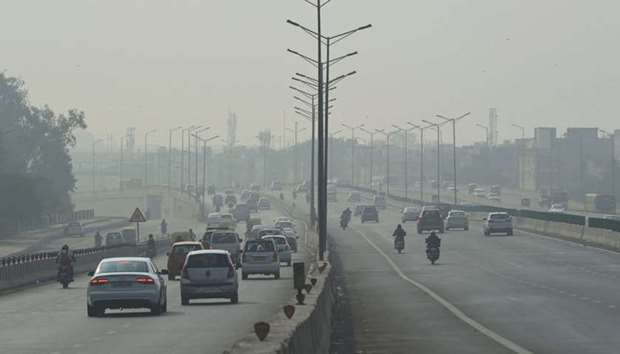New Delhi’s homeless will be given cotton masks to help them survive in the world’s most polluted major city, officials said yesterday, although experts said the basic coverings would be useless against deadly smog particles.
Each winter the capital of 20mn chokes through haze so extreme that levels of airborne pollutants eclipse safe limits by more than 30 times.
The poor and homeless suffer the worst, through constant exposure to a toxic brew of car fumes, factory exhaust and construction dust.
Measures to curb the smog - from reducing heavy goods traffic and firecrackers to banning farmers from using fire to clear their fields - have failed to clear the skies.
Bipin Rai from Delhi’s city government said that 10,000 face masks would be given “to homeless families, women, patients and children as pollution levels are on the rise”.
But experts said these masks offered little to no protection against the most poisonous pollutants in the air - particles known as PM2.5 so small they can penetrate the heart and cardiovascular system.
“These masks are redundant, as fine particles harmful to the human body will not be filtered out,” Vivek Chattopadhyay from the Centre for Science and Environment said.
“It is ineffective, and the government should instead offer medically approved masks.”
Rai, from Delhi’s Urban Shelter Improvement Board, defended the scheme.
“Has any expert who is commenting on the masks and their durability tested them? How can they comment on something they’ve not tried,” he said.
Levels of PM2.5 measured by the US embassy in Delhi yesterday showed readings hit 378 - more than 15 times safe limits.
According to weather analysts, the weather conditions are expected to remain the same till November 15.
With persistent threats of adverse health effects since Diwali, the System of Air Quality and Weather Forecasting And Research (SAFAR) yesterday cautioned people again against doing strenuous outdoor physical activities.
“If asthmatic, keep relief medicine handy. Stop outdoor activity early morning and after sunset. Go for a short walk instead of a jog and take more breaks. Stop any activity level if you experience any unusual coughing, chest discomfort, wheezing, breathing difficulty, or fatigue,” SAFAR warned.
Yesterday, apart from Gurugram (air quality index 191 or moderate), all other regions around Delhi suffered a severe air quality with AQI 411 in Noida, 423 in Ghaziabad, 401 in Greater Noida and 454 in Faridabad.
In Delhi, Chandni Chawk, Pitampura, Delhi University, Dhirpur and Mathura Road, among others, were the most polluted regions with PM2.5.
The World Health Organisation last year said exposure to air pollution killed 600,000 children around the globe every year.
Tiny particles in the air can be absorbed into the bloodstream and have been linked to chronic bronchitis, lung cancer and heart disease.
The report found that children in poorer countries are far more at risk, with a full 98% of all children under five in low- and middle-income countries exposed to PM2.5 levels above WHO air quality guidelines.

Commuters travel along a highway amidst heavy smog in New Delhi yestereday. Air pollution in New Delhi hit hazardous levels on November 8 after a night of free-for-all Diwali fireworks, despite Supreme Court efforts to curb partying that fuels the capital’s toxic smog problem.
